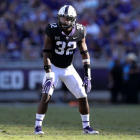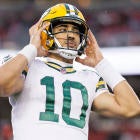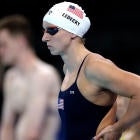Every year a host of seemingly worthy NFL draft prospects aren't invited to the combine, which certainly doesn't help their stock but doesn't automatically mean they'll go undrafted.
On average, around 15 percent of the players ultimately picked in the draft were not in attendance at the combine.
Last year, wideout Chad Williams from Grambling State didn't receive a combine invite but was selected by the Cardinals with the No. 98 overall pick.
These are the biggest 2018 combine snubs. You'll notice a trend.
Poona Ford, DT, Texas
Ford is the headliner combine snub on defense, and it's mainly due to his lack of prototypical size and the responsibilities he handled at Texas in his final season in Austin. At the East-West Shrine game, Ford was a fraction of an inch shorter than 6-foot, which clearly raised a red flag for evaluators. In his senior campaign, he played heads up on the center often and two-gapped frequently, which kept second-level defenders like Malik Jefferson clean. At his stature, Ford needs to be a penetrator in the NFL, and he has the athleticism and refinement with his hands to be that type of player, as evidence by his solid week of practice at the Senior Bowl.
Bradley Bozeman, C, Alabama
Bozeman was a captain on the national champion Crimson Tide and started 31 games for Nick Saban during his time in Tuscaloosa. He may not be the most swift mover at the center position but always appears calm and under control as a blocker. He was outstanding in 2016 for Alabama as well. At around 6-foot-4 and 315 pounds, Bozeman has NFL center size. This is real head-scratcher.
Ito Smith, RB, Southern Mississippi
Smith might be the owner of the most vicious jump cut in the entire running back class. For real. He averaged 5.85 yards per carry on his final 684 carries at Southern Miss and proved to be one of the most explosive receiving running backs in the nation, as he posted a 10.3 yards per reception mark from 2015 through 2017. I wrote a GIF-filled profile of Smith in January. He's good.
Daurice Fountain, WR, Northern Iowa
Fountain had an illustrious career at Northern Iowa, as he scored 23 touchdowns in his four seasons there with 2,077 receiving yards. As a senior, he had 66 grabs for 943 yards with 12 of those scores. He won MVP of the East-West Shrine game yet didn't get the "call up" to the Senior Bowl the following week. At 6-1 and 210 pounds with springy athleticism, Fountain checks the physical boxes too.
Jeremy Reaves, S, South Alabama
Reaves was the best player on South Alabama this season and was a pillar of production for his final three years in Mobile. After 96 tackles and two picks in 2015, he had 85 tackles with three picks in 2016. This season, Reaves' tackle figure jumped to 104, and he had three more interceptions to go along with eight pass breakups. At the Senior Bowl, he held his own during the week of practice. Being slightly under 5-11 with arms not quite 31 inches likely led to Reaves not receiving an invite.
Joe Ostman, DE, Central Michign
Ostman had 13 sacks and 19.5 tackles for loss in just 10 games for the Chippewa's in 2017. He plays with good bend, a nice arsenal of pass-rushing moves and a high motor. However, at 6-2 with 31-inch arms, Ostman was likely pegged as under-sized for the edge-rusher spot.
Ricky Jeune, WR, Georgia Tech
Jeune is probably the least physically-impressive of the Georgia Tech receiver alums like Calvin Johnson, Demaryius Thomas, and even Stephen Hill. That's quite the athletic trio though. Jeune is listed at 6-3 and 212 pounds and showcased impressive long speed on a variety of deep shots in the Yellow Jackets' triple-option offense. Beyond that, his concentration in contested-catch situations was excellent, and Jeune flashed some elusiveness after the catch.
Justin Lawler, DE, SMU
Lawler tallied 40.5 tackles for loss and 20.5 sacks in his last three years at SMU. At nearly 6-4 and 264 pounds, he possesses prototypical NFL defensive end size. At the East-West Shrine game, his arms measured in under 32 inches, which may be one of the reasons he didn't receive an invite. Lawler was steady on film, showcasing an array of hand usage and power at the point of attack. He didn't appear to be very twitchy as an athlete. That likely didn't help his combine candidacy.
Arrion Springs, CB, Oregon
Springs only had one interception in 2017, and it came in the bowl game against Boise State. That doesn't mean he failed to make plays on the football in college. He was credited with a whopping 42 pass breakups from his sophomore to his senior season. He was listed at 5-11 and 205 pounds but appears lighter on film. His smaller stature may have hurt his chances to compete at the combine.
Travin Howard, LB/S, TCU
Howard transitioned from safety to linebacker for TCU and was a tackling machine in his final two seasons. He had 130 tackles in 2016 and 108 in 2017. He snagged an interception in each of his three years for the Horned Frogs and broke up 10 passes, including seven in his senior season. Listed at 6-1 and 213, teams may be hesitant to use Howard as a linebacker in the NFL, but the position is rapidly evolving toward smaller, faster players, which makes it puzzling as to why he didn't get an invite.
Jaylen Smith, WR, Louisville
Smith had drop issues in college. Per Pro Football Focus, he was credited with 13 drops in three seasons and seven in 2017 alone. Then again, at around 6-3 and 215 pounds with above-average downfield speed and a career 16.9 yards-per-catch average, Smith seemed like a prospect worthy of a combine invite.

















